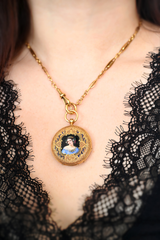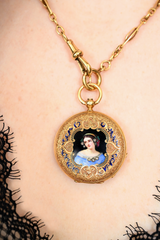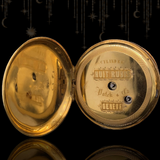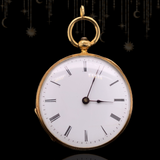Lace Jewels
18K Swiss Victorian Patek & Cie (Patek Philippe) Diamond Portrait Lady Enamel Pocket Watch with Bloodstone Winding Key

An exquisite Swiss Victorian c.1845-1851 Patek & Cie (Patek Philippe) diamond portrait lady enamel pocket watch and bloodstone winding key, modelled in 18k gold and hallmarked.
It is a rare and early Patek, where Patek & Cie was only established from 1845 to 1851. It is important to note that from 1845 to 1851, the time when this watch was made, Philippe had already joined Patek in its operations, and it was only in 1851 that Patek & Cie was renamed to Patek Philippe & Cie.
Here we have a watch from a pivotal, transitional time in the company’s history that represents Patek’s earliest client base. In the early days of Patek & Cie, Mr. Patek focused on selling to his nobleman friends, and accepted special requests and commissions. It is highly likely that this watch was a specially commissioned piece as it features the portrait of a lady which is rare to come across as the later Patek Philippe pocket watches often feature scenic landscapes. It also comes accompanied with its matching winding key.
The enamel work is wonderfully hand painted and is painted in great detail. The lady in the portrait has a graceful expression and her hair and dress is adorned with sparkly rose cut diamonds approx. 0.07ctw by spread. The entire case is engraved with repousse detailing and further decorated with enamel swirl patterns. It is truly wonderful!
It is hallmarked '18K' on the inside of the watch case, as well as signed with "Patek & Cie" on the inner dust cover.
The accompanying winding key is also crafted in 18k gold, and set with a lovely bloodstone which has specks of red and black. It can be used as a pendant charm on its own.
The watch is in running and working condition, and was recently fully serviced.
We have also included two additional winding keys - One to set the time, and one to wind the watch.
The watch measures 33mm across and weighs 23.06 grams. The bloodstone winding key measures 7.5mm x 28.7mm height, and weighs 2.28 grams.
This is a rare offering that is offered in great condition, and would be a wonderful addition to any antique lover's collection.
Patek & Cie - The Early Patek Philippe Before Its Rename In 1851
"Patek
Antoine Norbert de Patek (1812-1877). A Pole who settled in Geneva in 1835. He took an interest in highly valuable pocket watches and acquired a significant clientele. In 1839, he founded Patek, Czapek & Cie. He subsequently met watchmaker Jean-Adrien Philippe in 1844 and suggested that they become associates. He then changed the name of the Manufacture in 1845 to become Patek & Cie. It only became Patek Philippe & Cie in 1851.
Philippe
Jean-Adrien Philippe (1815-1894). A French watchmaker who invented the keyless winding and time setting system in 1842. He met Antoine Norbert de Patek in 1844 in Paris, during an exhibition of his invention. He joined Patek in Geneva the following year. Founded on May 15th 1845, the Patek & Cie company became Patek Philippe & Cie in 1851." - The entire above excerpt is provided by Patek Philippe. Click here for the page written by Patek Philippe on its glossary page.
More Indepth History - Its Journey from Patek & Cie, to Patek Philippe & Cie
"Before founding the company in 1839, Antoine Norbert de Patek (1812-1877) was a military officer who fought for Poland’s freedom from the Russians. After three years in the military, for which he was awarded the Polish military gold cross, he settled in Geneva in 1833 for what was intended to be a brief stay. His artistic pursuits led him to study under the famous Swiss painter Alexander Calame, under whose tutelage he refined his skills as a landscape painter. As early as 1835, perhaps as a side business to fund his studies, Patek bought watch movements and cases and sold them to his Polish friends. He soon realized his relationship with the Polish aristocracy was a lucrative opportunity for him to start a watch business to service this affluent clientele.
After Patek founded the company in 1839, together with his first partner Francois Czapek, his goal was to develop a successful watchmaking company in Geneva and eventually move the watchmaking firm to Poland once the political situation in Poland was stabilized. In a letter written in 1843 from Patek to a member of the Polish royal family named Princess Czartoryska, Patek referred to his newly founded watchmaking company as Poland’s “national manufacture, where we try to gather Polish workers… to bring back to our devastated Motherland this important branch of industry.” When Czapek left the firm in 1845 due to numerous disagreements with his partner, Patek faced a challenge to continue building the company and developing new venues to sell his watches. Czapek quickly built a rival watchmaking firm that aggressively lured away many of Patek’s Polish customers, forcing Patek to look for other markets in which to sell his watches.
Jean-Adrien Philippe (1815-1894), an inventive French watchmaker, first came to Patek’s attention in Paris after Philippe won a gold medal at the French Industrial Exposition in 1844. Patek was at the fair to promote his brand while on the lookout for new ideas, and possibly a new partner. During the Paris fair, Philippe presented a new patent for a keyless stem winding and setting system that marked a great improvement over previous technologies. The new patent cleared the way for the successful production of pocket watches that enabled the wearer to wind and set the movement without a key, a system that kept the watch cleaner and more accurate. Patek saw an opportunity in partnering with Philippe and offered him a position within the firm as technical director in 1845. At the same time, Patek also took on a third partner, a lawyer named Vincent Gostkowski (1807-1884), and the company was renamed Patek & Cie.
Although Philippe was a partner in 1845, it was not until 1851 that Patek & Cie.’s name was formally changed to Patek, Philippe & Cie. and both men’s names appeared on the company’s watch dials. Philippe remained with the firm as both partner and technical director until his death in 1894. Philippe’s contributions to the company represent an endless list of technical developments, patents, and innovations. With the addition of Philippe to the firm in 1845, Patek & Co. was no longer a Polish company working in Geneva. It became an international firm headed by a marketing genius, Patek, and one of the best watchmakers in the world, Philippe. The company quickly established relationships with some of the best retailers in Europe." - The entire above excerpt is provided by Collectability. Click here for the page written by Collectability on its page.
Era - Victorian c.1845-1851
Materials - 18k gold / Rose Cut Diamond / Enamel
Carat Weight - Diamond: 0.07ctw by spread
Measurements - Watch: 33mm across / Key: 7.5mm x 28.7mm height













